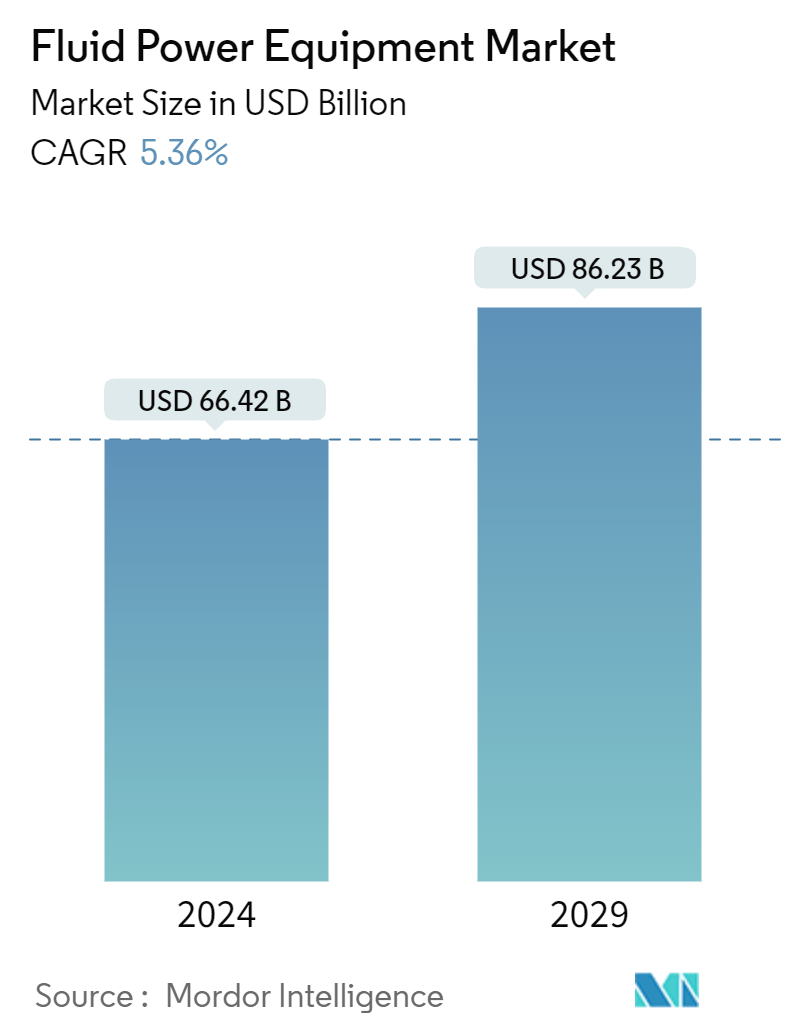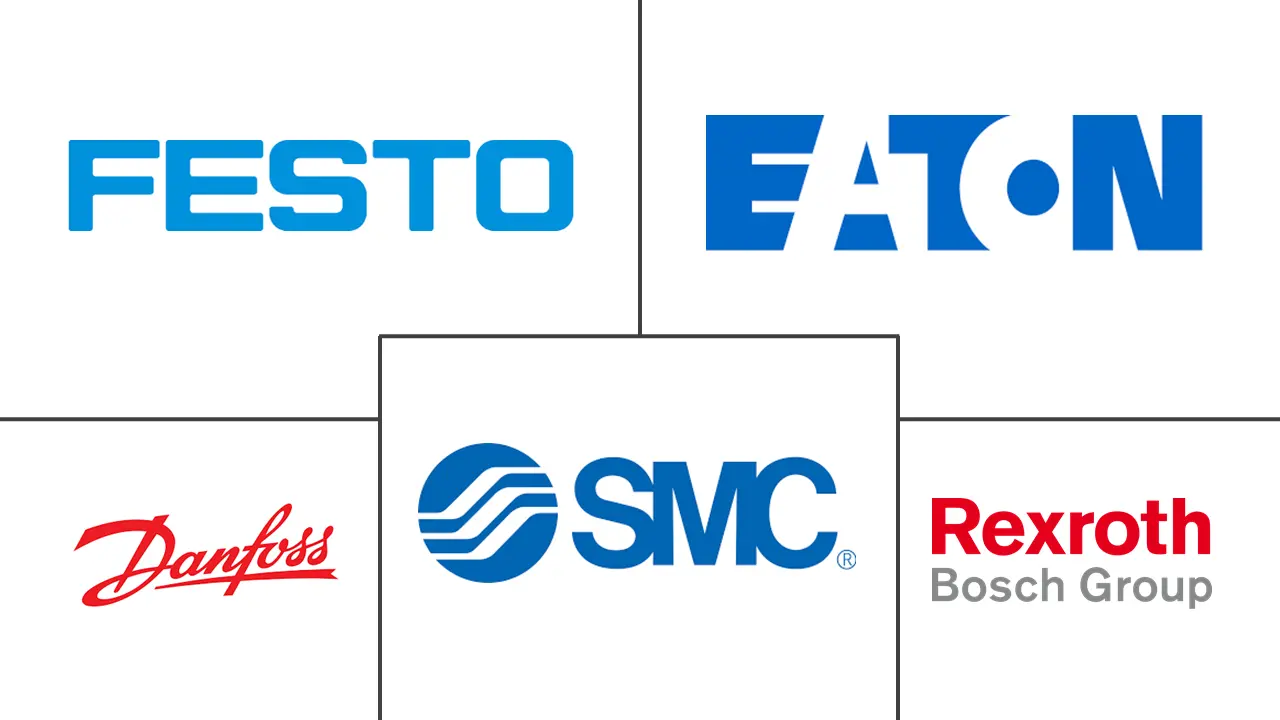Market Size of Fluid Power Equipment Industry

| Study Period | 2019 - 2029 |
| Market Size (2024) | USD 66.42 Billion |
| Market Size (2029) | USD 86.23 Billion |
| CAGR (2024 - 2029) | 5.36 % |
| Fastest Growing Market | North America |
| Largest Market | Asia-Pacific |
Major Players
*Disclaimer: Major Players sorted in no particular order |
Fluid Power Equipment Market Analysis
The Fluid Power Equipment Market size is estimated at USD 66.42 billion in 2024, and is expected to reach USD 86.23 billion by 2029, growing at a CAGR of 5.36% during the forecast period (2024-2029).
The fluid power equipment market is pivotal to numerous industries, including construction, agriculture, aerospace, material handling, and oil and gas. Fluid power systems utilize hydraulic and pneumatic technologies to manage energy via pressurized fluids, leading to the widespread use of equipment like pumps, motors, cylinders, and valves. These components are essential for sectors that require high precision, reliability, and efficiency in their operations.
Hydraulic Equipment Leads the Market
- Hydraulic equipment plays a dominant role in the market, offering powerful and reliable solutions, particularly suited for heavy machinery and industrial applications. Products like hydraulic cylinders and valves are extensively used across sectors such as construction and manufacturing, where high force and precise control are critical. While pneumatic equipment is less powerful, it is preferred in industries such as food processing and automotive assembly, where speed, simplicity, and safety are key considerations.
Technological Advancements Drive Demand
- Demand for fluid power components is fueled by technological developments in hydraulic and pneumatic systems, energy efficiency regulations, and growing automation trends. Integrating fluid power technology into industrial control systems has led to innovations, particularly in sectors like aerospace and oil and gas, where hydraulic machinery and fluid power control systems are being refined for enhanced efficiency and reduced environmental impact.
Advances in Industrial Automation Fuel Demand for Fluid Power Systems
- Incased Automationre: The ongoing shift toward automation in various industries is significantly impacting the fluid power equipment market. Hydraulic and pneumatic systems are increasingly integrated into automated industrial machinery, offering superior precision and control. This demand is particularly strong in factory automation, where efficient manufacturing processes and reduced labor costs are prioritized.
- Hydraulic Motors and Pumps Expansion: Industrial pumps and hydraulic motors are gaining wider use in sectors such as material handling and aerospace. Automation enables faster, more precise operations, driving further demand for fluid power equipment innovations that improve reliability and operational efficiency.
- Industry 4.0 Integration: As part of the Industry 4.0 transformation, fluid power technology is evolving to include smart sensors and advanced control mechanisms. These allow real-time monitoring and adjustments, minimizing downtime and enhancing performance in industrial hydraulic machinery.
- Pneumatic Equipment in Automotive and Semiconductor Manufacturing: Industries like automotive and semiconductor manufacturing are increasing their reliance on fluid power applications due to the growing complexity of production processes. Pneumatic systems are becoming essential for assembly lines and robotics, valued for their speed, flexibility, and safety.
Energy Efficiency and Environmental Considerations Shape Market Outlook
- Energy Efficiency Focus: As environmental regulations become stricter, energy efficiency is a growing concern for manufacturers of hydraulic and pneumatic systems. These systems are being re-engineered to minimize energy consumption and reduce emissions, in line with global sustainability goals.
- Redesign of Hydraulic Valves and Cylinders: Hydraulic valves and cylinders are undergoing significant redesigns to enhance energy efficiency. Fluid power transmission systems are being equipped with energy-efficient motors and pumps, which help to reduce operational costs and environmental impacts across industries.
- Increased Adoption in Construction and Agriculture: Energy-efficient hydraulic solutions are gaining traction in sectors like construction and agriculture, where equipment such as excavators and tractors operate under challenging conditions. Advanced control systems are being introduced to optimize energy use without sacrificing performance.
- Optimized Pneumatic Valves: Pneumatic valves and actuators, frequently used in industries such as packaging and food processing, are being optimized for energy savings. By operating at lower pressure levels, these systems reduce energy consumption while maintaining high-speed and precision in industrial applications.
Fluid Power Equipment Industry Segmentation
Fluid power is a term describing hydraulics and pneumatics technologies. Fluid Power Equipment comprises equipment that uses a fluid (liquid or gas) to transmit power from one location to another. The fluid is a liquid (usually oil) with hydraulics, whereas pneumatics uses gas (usually compressed air).
For both the hydraulic and pneumatic categories, the study only considers revenue accrued from the sales of equipment used in the production of end products. It does not reflect the revenues of finished goods.
The fluid power equipment market in which hydraulic equipment market is segmented by product type (pumps, motors, valves, cylinders, accumulators & filters), end-user vertical (construction, agriculture, material handling, oil and gas, aerospace and defense, machine tools, hydraulic tools) and geography (North America, Europe, Asia-Pacific, rest of the World). The pneumatic equipment market is segmented by product type (valves, actuators, FRLs, fittings), end-user vertical (food processing and packaging, automotive, material handling and assembly, chemicals/plastics/oil, semiconductor, and electronics, metalworking, paper and printing, life sciences) and geography (North America, Europe, Asia-Pacific, rest of the World). The market sizes and forecasts are provided in terms of value (USD) for all the above segments.
| By Product Type | |
| Pumps | |
| Motors | |
| Valves | |
| Cylinders | |
| Accumulators and Filters | |
| Other Product Types (Transmission, Fluid Connectors, etc.) |
| By End-user Vertical | |
| Construction | |
| Agriculture | |
| Material Handling | |
| Oil and Gas | |
| Aerospace and Defense | |
| Machine Tools | |
| Hydraulic Tools | |
| Other End-user Verticals |
| By Geography | |
| North America | |
| Europe | |
| Asia-Pacific | |
| Rest of the World |
Fluid Power Equipment Market Size Summary
The fluid power equipment market is experiencing robust growth, driven by advancements in automation and the integration of hydraulic and electrical systems. The industry is evolving towards more intelligent and connected systems, with a significant shift from analog to digitized hydraulic technology. This transition is facilitated by the adoption of Industry 4.0 principles, which emphasize smart and automated solutions across various sectors such as food processing, automotive, and construction. The market is also witnessing increased demand for pneumatic equipment due to its energy efficiency and flexibility in design, catering to the needs of diverse applications. The COVID-19 pandemic highlighted the importance of customization and resilience in the market, as companies adapted to supply chain disruptions and changing consumer demands.
In North America, the fluid power equipment market holds a significant share, supported by ongoing manufacturing and R&D activities, as well as initiatives to enhance worker safety in industries like oil and gas. The construction sector's growing demand for hydraulic equipment further propels market expansion, with innovations such as electric construction machines and advanced hydraulic systems being introduced. The region's market is also benefiting from stringent FDA guidelines, which promote the use of cleaner pneumatic equipment in food processing applications. The market is moderately consolidated, with key players like Bosch-Rexroth AG, Danfoss AS, and Eaton Corporation investing in strategic partnerships and product developments to enhance their market presence and drive further growth.
Fluid Power Equipment Market Size - Table of Contents
-
1. MARKET INSIGHTS
-
1.1 Market Drivers
-
1.1.1 Energy Efficiency and Environmental Considerations Shape Market Outlook
-
1.1.2 Advances in Industrial Automation Fuel Demand for Fluid Power Systems
-
1.1.3 Technological Advancements Drive Demand
-
-
1.2 Market Challenges
-
-
2. MARKET SEGMENTATION - GLOBAL HYDRAULIC EQUIPMENT MARKET
-
2.1 By Product Type
-
2.1.1 Pumps
-
2.1.2 Motors
-
2.1.3 Valves
-
2.1.4 Cylinders
-
2.1.5 Accumulators and Filters
-
2.1.6 Other Product Types (Transmission, Fluid Connectors, etc.)
-
-
2.2 By End-user Vertical
-
2.2.1 Construction
-
2.2.2 Agriculture
-
2.2.3 Material Handling
-
2.2.4 Oil and Gas
-
2.2.5 Aerospace and Defense
-
2.2.6 Machine Tools
-
2.2.7 Hydraulic Tools
-
2.2.8 Other End-user Verticals
-
-
2.3 By Geography
-
2.3.1 North America
-
2.3.2 Europe
-
2.3.3 Asia-Pacific
-
2.3.4 Rest of the World
-
-
2.4 Vendor Market Share Analysis - Hydraulic Equipment Market
-
-
3. MARKET SEGMENTATION - GLOBAL PNEUMATIC EQUIPMENT MARKET
-
3.1 By Product Type
-
3.1.1 Valves
-
3.1.2 Actuators
-
3.1.3 FRLs
-
3.1.4 Fittings
-
3.1.5 Other Product Types
-
-
3.2 By End-user Vertical
-
3.2.1 Food Processing and Packaging
-
3.2.2 Automotive
-
3.2.3 Material Handling and Assembly
-
3.2.4 Chemicals/Plastics/Oil
-
3.2.5 Semiconductor and Electronics
-
3.2.6 Metalworking
-
3.2.7 Paper and Printing
-
3.2.8 Life Sciences
-
3.2.9 Other End-user Verticals
-
-
3.3 By Geography
-
3.3.1 North America
-
3.3.2 Europe
-
3.3.3 Asia-Pacific
-
3.3.4 Rest of the World
-
-
3.4 Vendor Market Share Analysis - Pneumatic Equipment Market
-
Fluid Power Equipment Market Size FAQs
How big is the Fluid Power Equipment Market?
The Fluid Power Equipment Market size is expected to reach USD 66.42 billion in 2024 and grow at a CAGR of 5.36% to reach USD 86.23 billion by 2029.
What is the current Fluid Power Equipment Market size?
In 2024, the Fluid Power Equipment Market size is expected to reach USD 66.42 billion.

